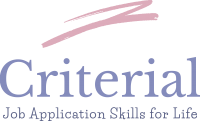Selection Criteria Examples: My Responses To A Real Job Description
In this blog I want to give some full selection criteria examples, and talk through them about their layout. I don’t do this a lot as most of the selection criteria I deal with are not mine to share but this one is.
A question I am occasionally asked is do I apply for jobs very often and how successful am I?
That is a fair question. The last time I was applying for a job I wrote the Why your next government job application should start with a coffee blog but I did not end up submitting an application because of some personal stuff going on.
This is the job description if you’re interested.
Selection Criteria Examples With Responses
If you’re interested in reading through a more detailed description of linking it to the position description, STAR method and my training courses, you can do that after the selection criteria example shown below.
As you read these selection criteria examples, what should stand out is that most of the content relates to me personally.
It is about what I did, how, why and my experience.
You cannot just download this off the internet but I can teach you how to write selection criteria yourself.
Role Capability Outline – Vision
Stimulates ideas and innovation – Supports the team to generate actionable insights from data and empowers the use of technology to drive new efficiencies
Leads change in complex environments – Empowers others to understand and embrace change by communicating openly about the rationale and intended outcomes
Selection Criteria Response
I am a visionary when it comes to using data in TMR. I was employed in 2010 in Transport Services (now CSB) to deliver the compliance intelligence and higher-level legal matters scope of work for __ . This involved establishing an analytical function to examine the heavy vehicle industry and environment to deliver actionable advice for targets for compliance enforcement and education. This was a greenfield piece of work with no systems or process in place. I commenced work, reviewed the environment and systems, prepared a plan for adoption by senior leadership and commenced work on the plan. Assisted by one AO6 intelligence analyst within two years we delivered an intelligence analysis system capability in the form of the i2 iBase and i2 Analysts Notebook products including GITC contracts and ITB systems, collection systems via Microsoft SharePoint, and rating systems for analysing TRAILS infringement and defect data to identify patterns of serious non-compliance in high-risk areas such as speeding and brake defects. The i2 iBase system has grown over the years and now serves Compliance for all their case management and audit recording. It also serves TransLink personalised transport for recording details of service delivery by CSB Compliance.
I also undertook the change management for the implementation of the intelligence and higher-level legal investigations capability. For both intelligence and investigations, knowledge and skills within CSB were very limited; the enforcement culture was based on writing infringement notices for roadside offences. The change management in investigation processes involved a review of skills and processes by my AO7 investigations manager. After the review, he set about delivering the changes and me the management. The change management was focussing on the hand in glove nature of intelligence analysis and advice, leading to investigation of companies. This relied on management buy in for each compliance region, delivering actionable results and celebrating them in a visible way, and, ensuring voices were heard as changes were made so we could work at their pace and consider their feedback. Legacies still in place today from this include the moot court process for Transport Inspector recruits run today by prosecutions section. Many transport inspectors have never been to court, nor understand what it involves, and the moot court process is an important legacy of the change giving them the experience in a safe environment.
Applying the STAR Method
Looking at the selection criteria examples visually you can see the breakout of STAR Method (or SAO – Situation, Action, Outcome).
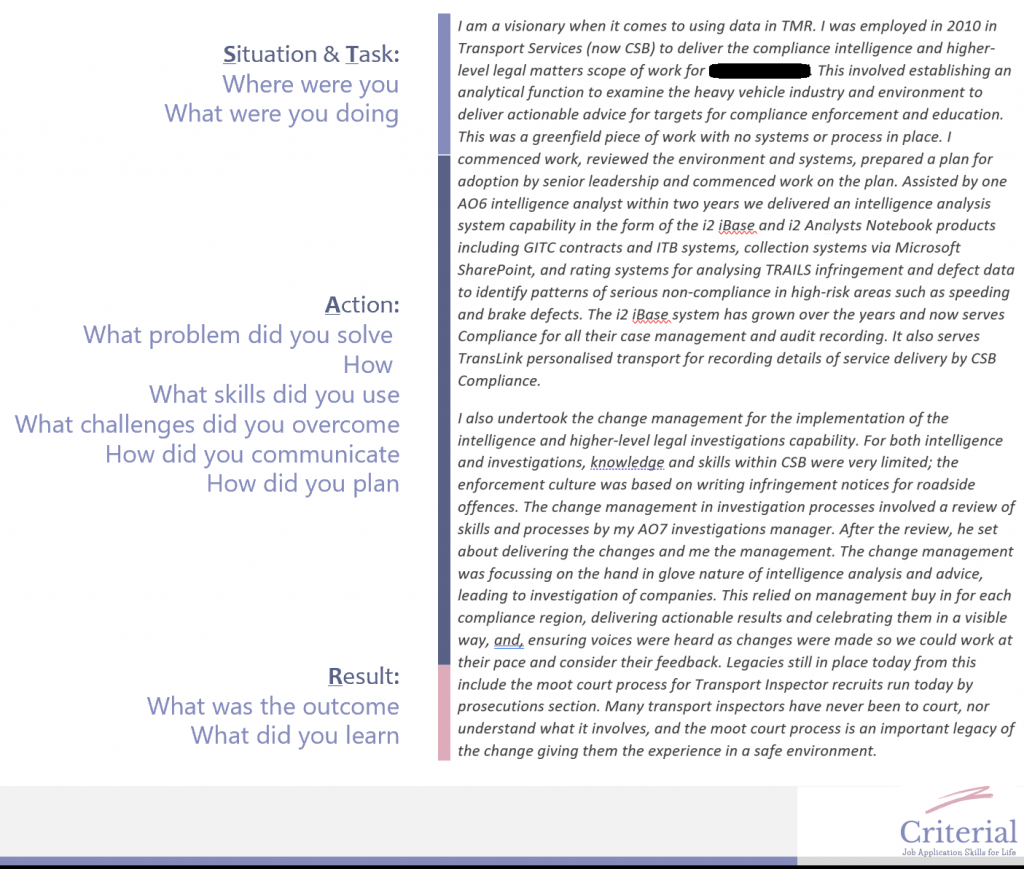
Most of the content in the selection criteria examples is about the action. You see from reading this it is my story and my experience. What you need to do is tell the story, so someone who doesn’t know you can read the story and understand your skills and how you work.
I cannot give you selection criteria examples for your experience because your experience us unique to you. I can teach you these easy to learn skills in as little as an hour, maybe two. You can see above the content is roughly in the proportions of:
- ST (Situation Task) 20%
- A (Action) 60%
- R (Result) 20%
That is about what you want to aim for. Once again, you need to tell your story, your case study.
Role Capability Outline – Results
Develops and mobilises talent – Implements development plans with direct reports to address skill and knowledge gaps and enhance the capabilities they require for current and future roles. Encourages self-reflection, and provides clear, timely and accurate feedback on progress against agreed goals
Builds enduring relationships – Initiates two-way collaborations by providing information and advice in a timely, proactive and non-technical manner, supporting the team to do the same
Drives accountability and outcomes – Works with the team to develop shared objectives and clear indicators for success, empowering others to take ownership for the delivery and quality of outcomes achieved
Selection Criteria Response
I have shown I can develop and mobilise talent recently working with an AO6 intelligence analyst who had been with me three years. As progression in intelligence analytics is limited within TMR, I worked with the staff member to map her plan. She was targeting Executive Level 1 (EL1) roles in the commonwealth government, which require considerable management experience according to the Integrated Leadership System (ILS) profile but commence at similar salary to AO6. I contacted the Manager Employee Development Program in LTSR to discuss shadowing opportunities as the HVOps section has no available AO7 roles, and limited supervision opportunities. We identified CSB Customer Service Centre’s would provide a wealth of opportunity so established a partnership. We mapped activities the CSC supervisors perform to those the staff member needed development, and, set in place one day a week for her to attend a CSC to undertake work. At the same time, I assisted in writing skills for job applications which ensured she was obtaining interviews although coming up short on experience. The staff member has just this week moved on from TMR commencing as an APS6 negotiating a starting salary at top of range. This came about as she was identified in interview as being suitable and asked to apply for the vacancy where she could both develop her intelligence analysis skills as well as having opportunity to develop management experience. In her final goodbye email, she stated “Richard, not only are you a great manager, you are also an amazing mentor and leader. Thank you for being my biggest champion and guiding me along the way”. I have worked with several staff through training, SARAS assisted university study and providing my analytical experience training as an analyst in 1997.
I have shown my ability to build enduring relationships and drive accountability and outcomes while I have been working at TMR, having commenced in the Information Systems Branch in 2007. In 2020 considerable background project work has been done to replace the Conditions of Operation Database (CoOD) but no progress had been made on delivery. The National Heavy Vehicle Regulator provided a quote of $180,000 to host the data in their portal, which was expensive and would mean TMR losing control of their own data. I proposed to replace the database with a Cloud hosted solution utilising internal data analyst resources, and Cloud architects from Amazon Web Services (AWS). Running the procurement process from end to end, I obtained a quote of $ __ to deliver this however funding was operational and tied to the 2021 financial year. I leveraged relationships in ITB with the Cognos DataStage resources, TRAILS resources, Database Administrators and Middleware teams to deliver this using business as usual (BAU) resources. I did this by being known, having clear shared objectives that were win/win for everyone and where I contributed resources to assist in doing work. The win/win was important as I needed to replace a legacy system and spatially enable customer data, but it was as system I understood was also a liability to ITB. It was impacted by being on premises Oracle, the Windows Process Activation Service had a very unusual J2EE framework and involved the IBM DataStage product. With each area I established clear indicators for success and through relationship and engagement, I delivered the ITB work for this project with BAU resources and without impacting their other activities.
Applying the STAR Method
Looking at the selection criteria examples visually you can see the breakout of STAR Method (or SAO – Situation, Action, Outcome)
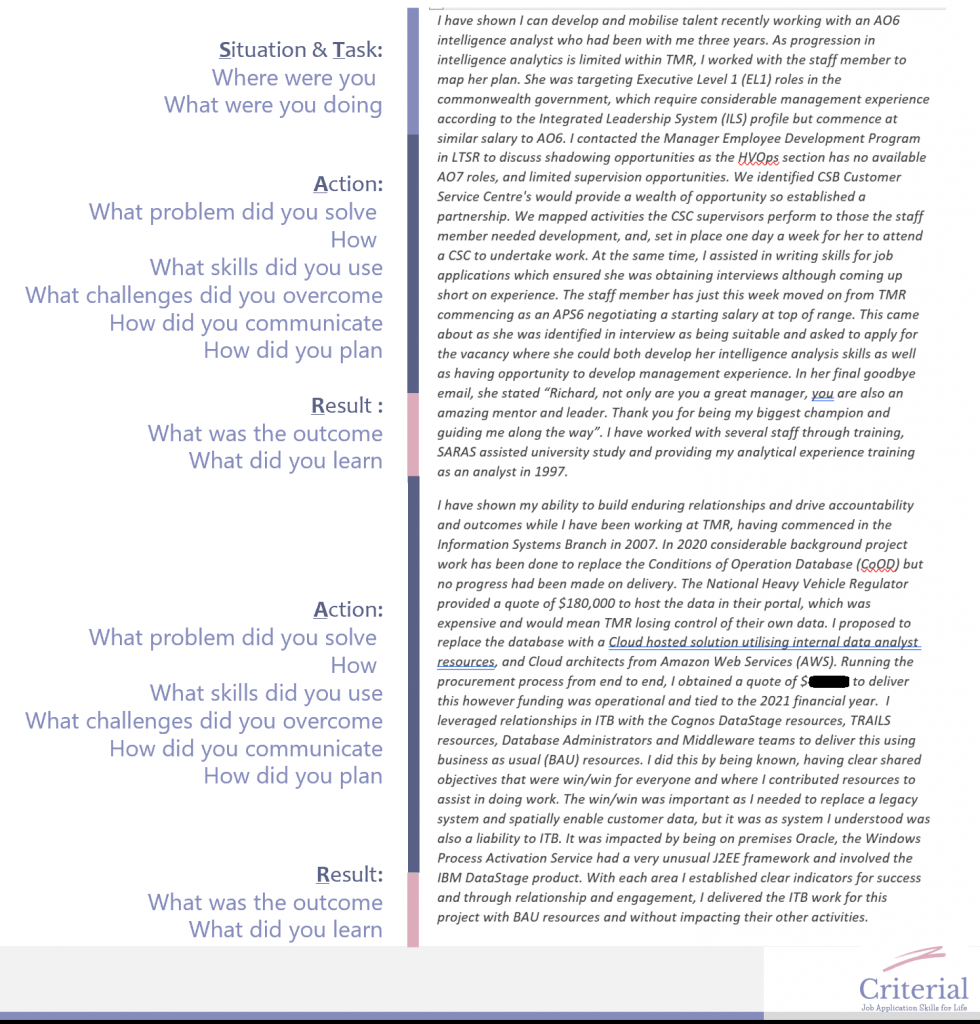
You’ll see here there is one ST, and two AR’s.
This is because I have used the one example to address two criteria:
- Develop and mobilise talent recently
- Builds enduring relationships
This is perfectly okay to do, at the end of the day all you need to do is address the criteria. It doesn’t matter how you do it or in what order or whether you use one example to address one, two or four criteria. I can teach you these skills in about an hour and you can use them to address any criteria you ever want to
On building relationships, this is a significant question in any selection criteria response and it is asked for a specific reason, as I discuss in relationship building key selection criteria why blog.
Role Capability Outline – Accountability
Pursues continuous growth – Embraces opportunities to expand knowledge and experience through networks, new assignments and development avenues
Demonstrates sound governance – Promotes integrity in the management and use of processes and resources, ensuring others have the information and training they need for successful implementation.
Works with the team to evaluate options and develop appropriate plans to mitigate risks.
Selection Criteria Response
I have referred to pursuing continuous growth above regards staff development, I also approach this as a BAU activity. Evidence of this is the implementation of Cloud analytics within HVOps. In 2019 with the formation of the TMR Data and Business Analytics (D&BA) capability I saw an early opportunity to leverage their resources being a new team with a new scope. The Intelligent Access Program (IAP) system relied on decade old on premises Oracle and had not had development for over ten years and Transport Certification Australia (as the specification owner) had no lifecycle management in place. I contacted with D&BA team with a view to running a proof of concept of IAP in the AWS Cloud. Being a proof-of-concept minimised procurement overhead, allowed data analysts to work side by side with Cloud Architects and Data Engineers, and, allowed then hands on day-to-day opportunity to learn. As training in Cloud technology is readily available, often for free, I stayed across seminars and industry run development and always provided it to team members with encouragement to attend. I also encouraged attendance at TMR Community of Practice meetings, user groups for analytical tools, and allowed people work time to attend even if early evening. I also communicate outcomes from D&BA Working Group meetings such as the establishment of the Cloud hosted Active Directory replica so staff can access and use to meet their analytical needs.
Continuing discussing the CoOD replacement project, government for this was established in identifying funding and documenting records for RTAC, IFE’s, sole supplier and engagement of AWS. Project governance was run in the form of a Teams Agile Wall. Every second day a 15-minute Agile scrum was held to discuss and record any blocks issues or risks; and assigned for follow up. By doing this, risks were recorded as action items alongside all other protect activity. Everyone had visibility of who was doing what and where work was up to. As the project manager I had oversight of the entire project for LTSR, CSB and AWS to advise management of progress and escalate any issues. The CoOD replacement is now live in the AWS Cloud, a first for TMR for the back end of a customer facing system to be Cloud hosted.
Applying the STAR Method
Looking at the selection criteria examples visually you can see the breakout of STAR Method (or SAO – Situation, Action, Outcome)
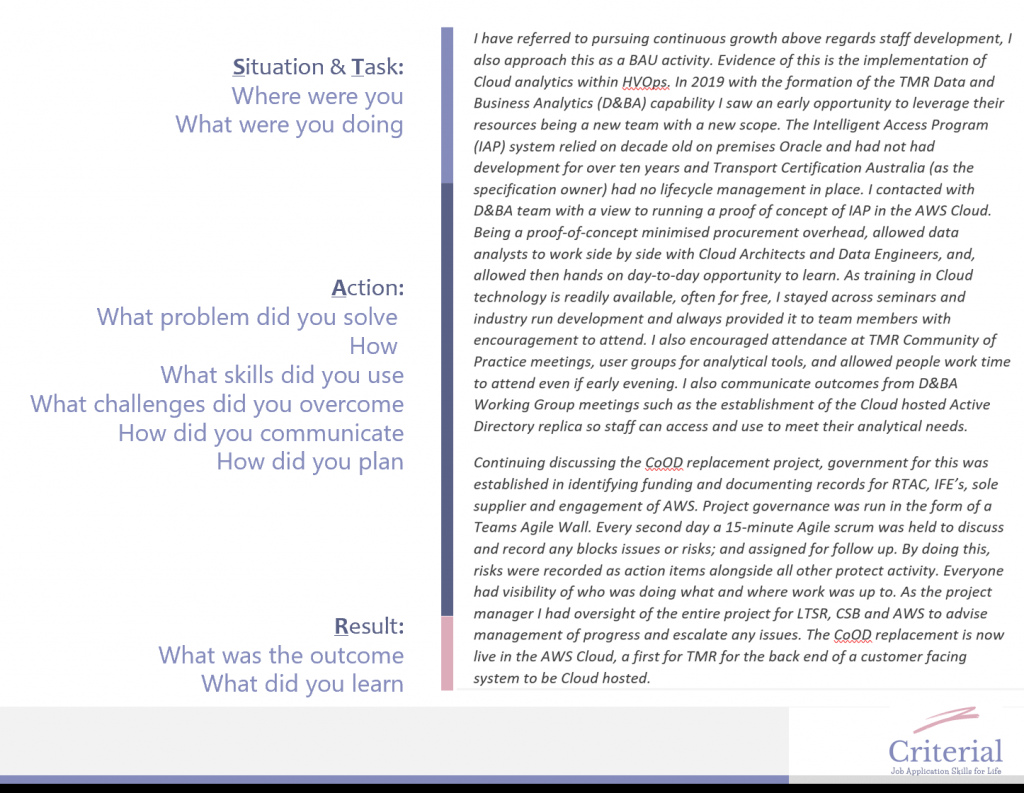
Once again, the focus is Action and telling the story of the example; what I did and how and why.
It is not about the STAR method itself, it’s about me and what I did.
That is what you need to supply from your examples in your selection criteria responses.
Go beyond the blog. enrol for comprehensive learning.
Imagine how much more you will learn in a course not just a blog!
Click Here to View Our CoursesCompetency Frameworks and Selection Criteria Examples
If you have read the position description, you will see a reference to “this role maps to Team Leader”.
There is even a specific reference to the competency frameworks in the Submit Your Application Section with a link.

All role descriptions and selection processes are required to be aligned with Leadership Competencies for Queensland (LCQ). For more information about the LCQ, visit https://www.forgov.qld.gov.au/leadershipcompetencies-queensland.
I discuss selection criteria competency frameworks in depth in the linked blog.
They are tedious and boring to read and understand, but, if you can get your head around these frameworks, particularly the competencies that are reused across all government jobs, you get ahead on applying because you can apply your skills to any role in any department.
Many competency frameworks also give you answers and examples of the types of skills they are looking for, basically they’re telling you the answers they want to see from you using your experience.
In this case for Team Leader for the selection criteria in this role, I will show below the “behavioural indicators” (examples of things you have done) they state they want for each will can guide your thinking.
- Vision
- Stimulates ideas and innovation
- Leads change in complex environments
- Results
- Develops and mobilises talent
- Builds enduring relationships
- Drives accountability and outcomes
- Accountability
- Pursues continuous growth
- Demonstrates sound governance
- Works with the team to evaluate options and develop appropriate plans to mitigate risks
From this list, the right-hand column shows “behavioural indicators” which once again are examples they are looking for.
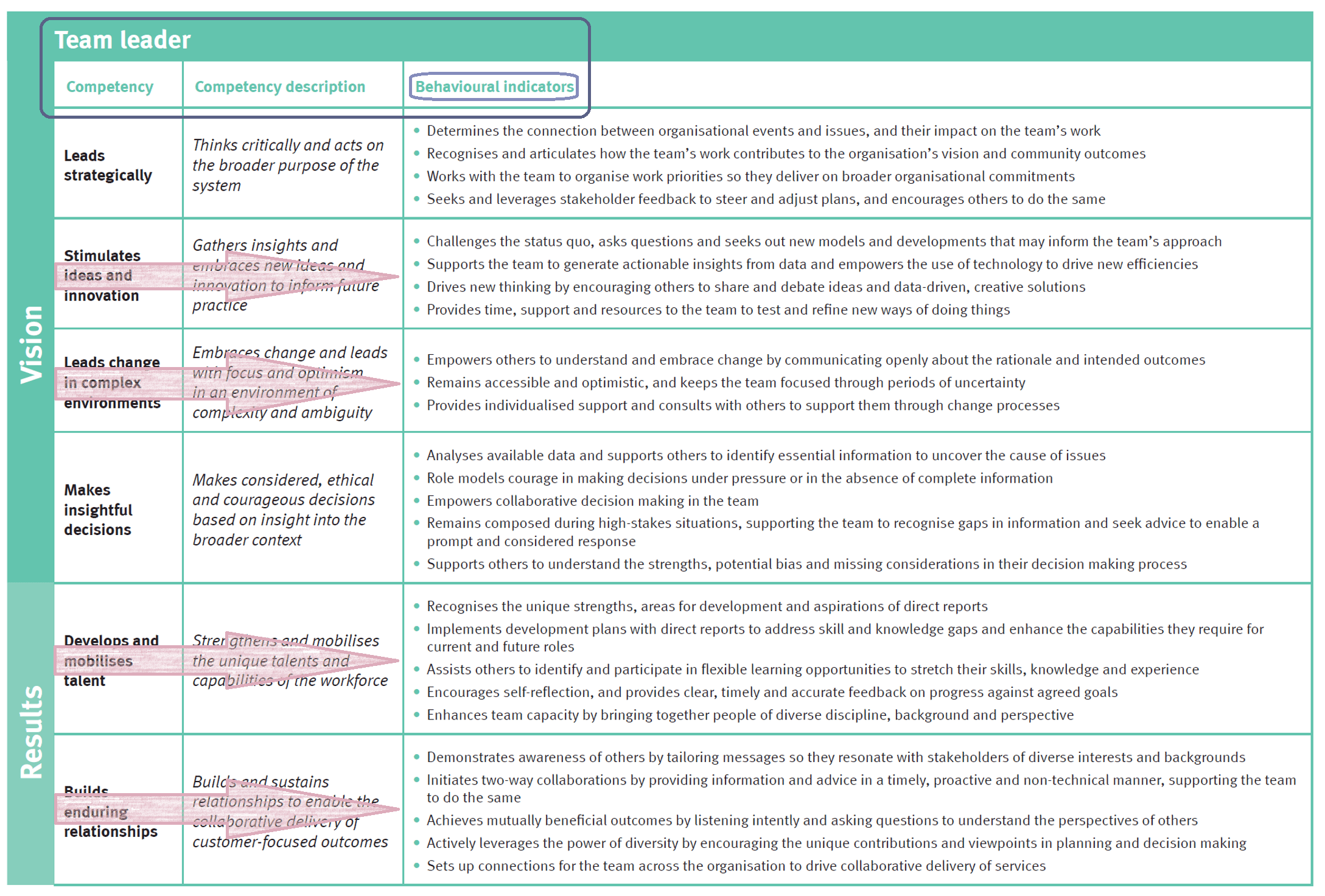
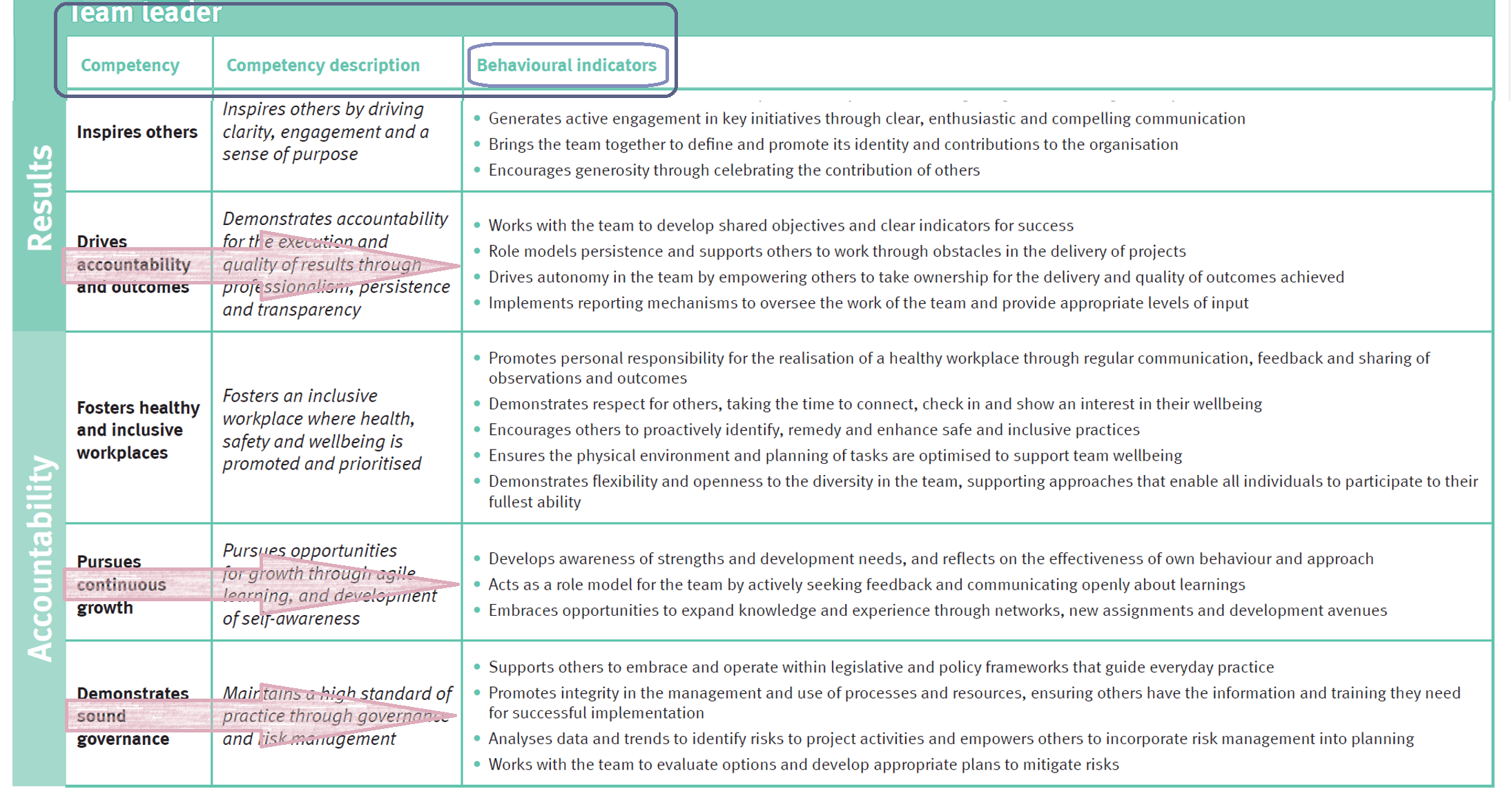
For vision, the first dot point shows:

- Challenges the status quo, asks questions and seeks out new models and developments that may inform the team’s approach
- Supports the team to generate actionable insights from data and empowers the use of technology to drive new efficiencies
- Drives new thinking by encouraging others to share and debate ideas and data-driven, creative solutions
- Provides time, support and resources to the team to test and refine new ways of doing things
Can you use that list to think of examples from your career where you have done these things? If you can then you have a good answer for that criterion!
Yes it really is that easy and I go into depth on how to understand and use this information in my online courses.
Every government has one of these frameworks; they literally post online examples of the answers you need to give. Why? I make it easy for you to apply and show your skills.
Do You Have Questions?
You can book a free, no obligation, 15 minute consultation to discuss your questions about this blog or anything else, just click below.
Book HereMandatory and Desirable Criteria
Returning to my application and the position description, the position description outlines several desirable technical requirements:
- Tertiary qualifications at the degree level or higher in Computer Science, Technology, Statistics, Modelling, Mathematics, Economics, Engineering, Transport Planning, Geospatial Information System (GIS), or a numerate discipline would be an advantage.
- Experience in designing, developing, and implementing transport models and data models using cloud-based data and analytics technologies, program languages and statistical software tools (such as Amazon Web Services, Python, Glue, Athena, Matilion, Snowflake and Alteryx).
Desirable and mandatory criteria obviously differ, and I discuss these in mandatory or discretionary selection criteria requirements blog. In that blog and in my training courses I suggest dealing with these quickly as I did in my application:
Dear __
I am writing to apply for the position of Manager – Business Intelligence and Performance (job ad reference QLD/402530/22).
I meet the desirable technical requirements as follows:
Tertiary qualifications at the degree level or higher:
- I hold a Graduate Diploma (Criminal Intelligence Analysis) with distinction (GPA 6.2)
Experience in designing, developing, and implementing transport models and data models using cloud-based data and analytics technologies, program languages and statistical software tools (such as Amazon Web Services, Python, Glue, Athena, Matilion, Snowflake and Alteryx).
- I have extensive team leader experience delivering business outcomes, leading a variety of types of analysts (individual contributors) including:
- Data scientists and data analysts (including some of the team members of this team) using Amazon Web Services,
- Spatial analysts using Amazon Web Services, and,
- Criminal intelligence analysts.
- I have been a highly valued manager for over a decade in TMR and years before that in Queensland Police.
- I have extensive team leader experience delivering business outcomes, leading a variety of types of analysts (individual contributors) including:
Feedback I obtained this year in a business improvement process run in Heavy Vehicle Operations (HVOps) reads:
“…regarding your team I think they are the happiest team I have ever done this process with and really didn’t identify anything that they want to work on” ( __ by email Monday, 11th October 2021).
I am a valued and contributing member of the TMR data and business analytics working group, and, have experience with TransLink working with __ and __ providing advice regards personalised transport fatigue analysis, and __ and __ regards PTDoc replacement.
I have worked in Information Technology Branch (ITB), Transport Network Security resilience (TNSR), TransLink, Customer Services Branch (CSB) and Land Transport Safety and Regulation (LTSR), which includes several transitions due to restructure as opposed to “moving on”. I have relationships across TMR generally as well as with other analytic teams I have worked with such as Transport Analysis Unit, Data Analysis, CSB Data Analysis Reporting Centre (DARC) and many others.
I look forward to undertaking the selection process and attach my statement addressing selection criteria and resume.
Richard Branch
They are easy to address, almost yes/no type criteria so you don’t need to go into lots of detail. Simply apply your experience to address how you meet them.
Selection Criteria Examples and Position Descriptions – Broad Discussion
I said at the start I would do a more in-depth walk through of relating the position description to the selection criteria response.
I’ll step through sections of the position description and my application in a roughly similar order to how my Completing Selection Criteria course does namely:
- The position description
- The selection criteria
- The STAR (SAO) method
As shown below from the course page:
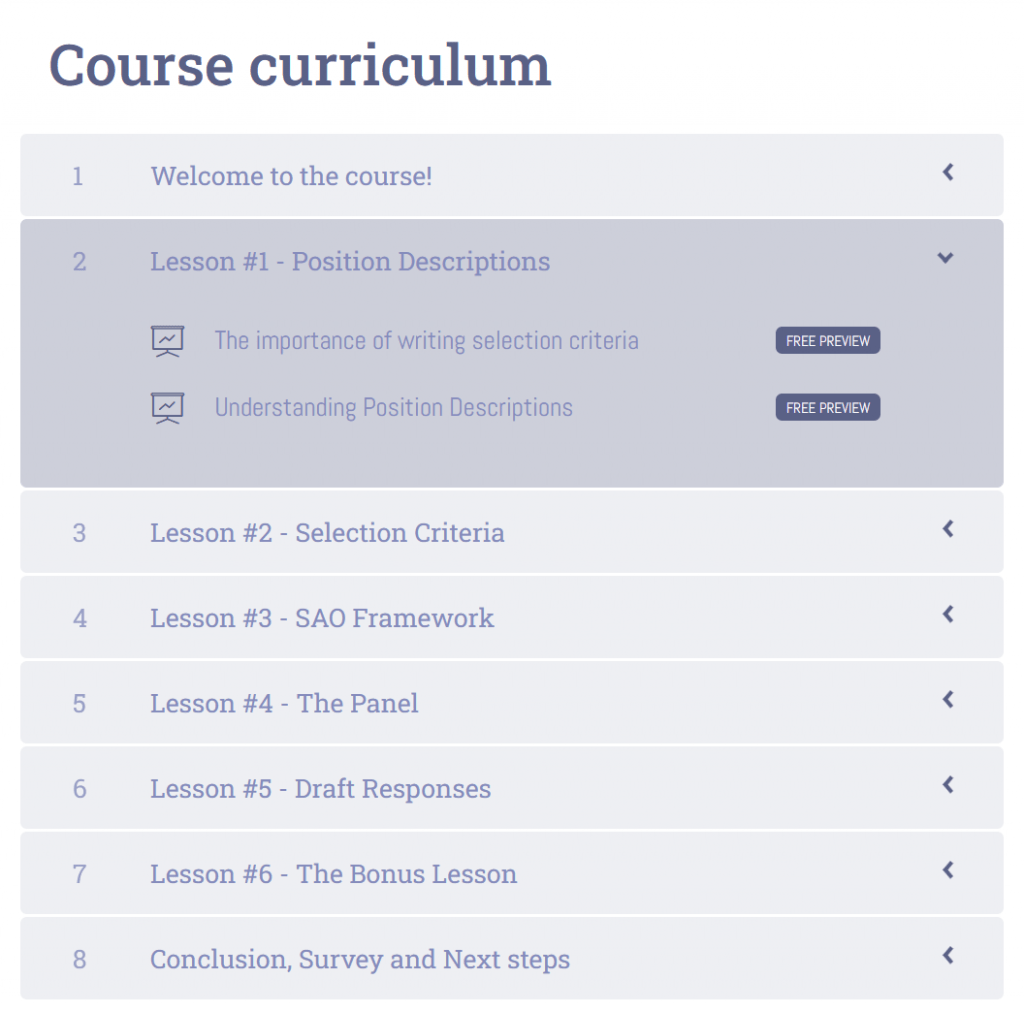
The Position Description
First things first; how to read the position description.
I discuss this in full in the free preview module of my Selection Criteria Training course.
Briefly here.
The Organisation
What you see below as both text and a picture is the Working at Transport and Main Roads section. This is a very brief view of the organisation, and, what it values. I talk about values and reflecting an organisation’s values in the courses suffice to say it helps to show you are a fit for the organisation if you hold the same values they do.
Have a look at this section below and think about what are their values?
Working at Transport and Main Roads
Transport and Main Road’s (TMR) vision is to create a single integrated transport system accessible to everyone.
We move and connect people, places, goods and services – safely, efficiently and effectively. The driving force behind all of these things are our people. We employ over 8500 dedicated employees who share a common value – to drive positive change and to make a difference.
TMR actively encourages teamwork and innovation. You will work for an organisation which offers professional development, a variety of interesting work state-wide, a safe, healthy and secure workplace and flexible work and lifestyle options.
Customers first. Ideas into action. Unleash potential. Be courageous. Empower people
Does that sound like somewhere you want to work? I can tell you it is a great place to be and in almost 30 years working, one of the best places I have been.
I just want to quickly talk about the graphic for this information too. There are five blue boxes at the bottom, look carefully:
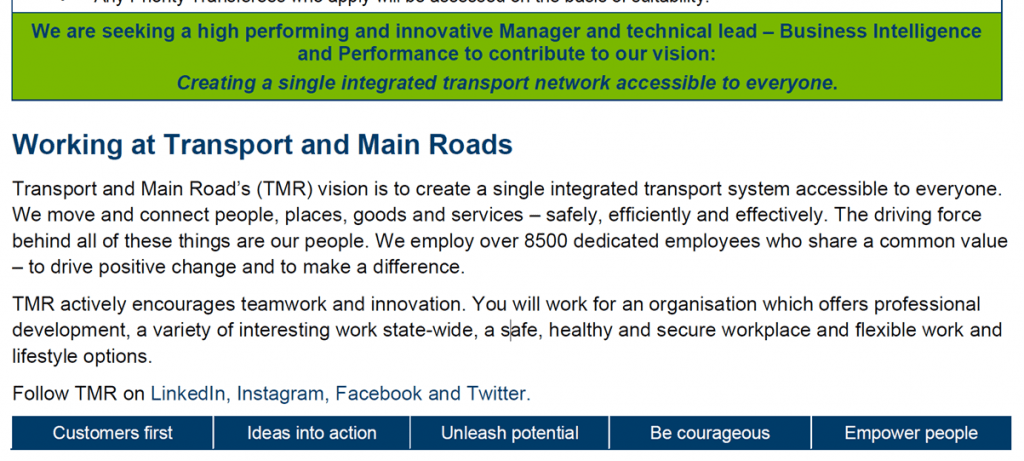
You may not have even seen them, or if you did you might have thought it was a border.
In the context of these appearing in the About Working at Transport and Main Roads section of the position description, what do you think these are?
They are the organisation’s values. A quick Google search the top result is https://www.tmr.qld.gov.au/About-us/Our-organisation/Vision-purpose-and-values shown below…
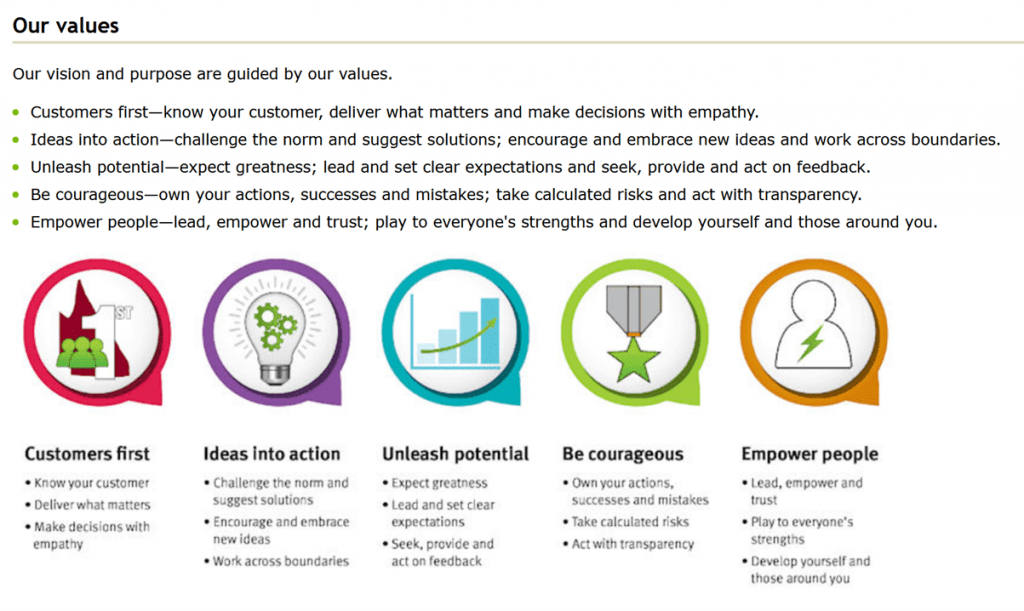
When you are giving your responses, these are fantastic words to work into your responses so that you show you align with their values. It also shows you have done some research which for the sake of working a few words into your application; give tremendous return on investment of time.
Your opportunity
The next section is Your Opportunity. In terms of hierarchy, the start is the organisation, sometimes there is something about the section you would be working in and then the role. In this case it discusses the role in context of the section it is in.
In the role of Manager and technical lead – Business Intelligence and Performance, you will be a valuable member of the Finance and Performance team and will contribute to TransLink Division’s strategic purpose of Connecting Queensland through the delivery of customer focussed passenger transport services. You will work in a rapidly evolving environment to ultimately lead performance management of passenger transport operations in Queensland.
As Manager and technical lead:
- You will have the capability to lead a team of technical specialists in cloud technology, data science, data engineering, transport modelling, data analysis and data visualisation, providing technical guidance and mentoring.
- You will have the ability to quickly identify meaningful and relevant trends using performance metrics to derive insights from complex and substantial data sets.
- You will have the capability to lead and contribute to the investigation, analysis, design and implementation of TransLink’s cloud data and analytics platform, including solution and data architecture, data warehousing and business processes that are cost optimised.
- You will be a self-motivated and driven stakeholder connector with the ability to work collaboratively to solve business challenges.
- You will have an awareness and understanding of the passenger transport environment and issues and will make recommendations that drive passenger transport contract, planning and operational performance and accountability to improve our customer’s experience.
- Your communication skills will enable you to translate complex analytical insights into clear and actionable recommendations for the business.
From reading that you should have a sense of what the team and role do, what they achieve in terms of the organisation. In this case the organisation exists to “…move and connect people, places, goods and services – safely, efficiently and effectively” and this role exists to “…delivery of customer focussed passenger transport services” so it fits.
Accountabilities
Drilling further into the position description, are the accountabilities.
This is the section of a position description that outlines what a job is responsible for day to day.
For this role the accountabilities are:
- Lead the provision of network performance and customer travel behaviour analytical and reporting products and services across TransLink to optimise network performance, customer experience and revenue generation.
- Oversee the development and implementation of cloud solutions to ingest, integrate and make available data from a range of source systems, to support BI&P products, including high quality and secure data marts for enterprise-wide use.
- Manage team priorities across a program of work in order to support a number of simultaneous projects and other key strategic priorities.
- Work at a project level to lead the development of new models, analytical tools, and dashboard products, including the ongoing evolution of the team’s cloud data and analysis platform in line with stakeholder requirements and TransLink priorities.
- Develop strong relationships with internal, departmental and external stakeholders (including but not limited to data and technology management companies, state transit service operators and government transport jurisdictions across the country).
- Leveraging your professional networks, gather information from a variety of data sources to undertake objective, systematic analysis and provide recommendations / insights on key performance indicators and resolution strategies to ensure effective and accountable passenger transit operations.
- Probe complex and extensive data sets to draw out key information to prepare presentations, reports and submissions to leadership and stakeholders, communicating concepts clearly and tailored to the audience.
Who doesn’t love a job that probes into things!
You can get a sense from these, even if you don’t know what some of the words mean, what the person in this role does day to day.
Criterial Courses
This is the very condensed version of what you’ll learn in my online training.
There are courses for:
- Completing selection criteria, and,
- Identifying your career examples
Identifying Your Career Examples
This is perhaps the most overlooked skill you can have when applying for jobs, especially those using selection criteria examples.
A lot of people spend a lot of time focussing on the STAR method, but STAR is just a framework, what matters is your example.
To rephrase STAR:
- Where were you (S),
- What were you doing (T)
- What problem did you solve and how, what skills did you use (A)
- What was the outcome (R).
As I showed above in my responses, about 60-80% of your response should be Action. Discuss your example like a case study:
- What you did,
- What skills you used,
- What obstacles you overcame,
- How you communicated,
- How you planned,
- How you used teamwork
The best way to answer interview questions is to focus on your examples and know your examples/career/work experience. Why? Because each example can be applied to multiple questions. If you are a project manager, your “project management” example can address:
- Project management,
- Communication,
- Teamwork,
- Planning and delegation,
- Meeting deadlines,
- Working under pressure,
- Stakeholder management,
- Negotiation,
- Meeting changing deadlines, or,
- Written documents/artifacts.
I discuss how to do this in Your Career Examples course.
Having one example that can address so many competencies, makes your experience widely applicable It also saves you trying to guess what they will ask you in interview. You can go into any interview and answer any question based on the example that fits best.
Share this post
